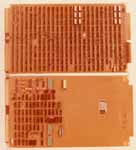Counters and Timers
N1 - Maximum number of bits in an I frame
N2 - Maximum number of transmissions
k - Maximum number of outstanding I frames
see also X.25 throughput issues
Timer T1
The value of the DTE timer 1 system parameter may be different than the value
of the DCE timer T1, the value of the DCE T1 timer is agreed at subscription
time, Public Network values are normally as follows:
| packet length | 128 | 256 | 512 | 1024 |
| 2400 bps | 2.4 seconds | 3.0 seconds | 6.0 seconds | 11.0 seconds |
| 9600/19200 bps | 1.0 seconds | 1.0 seconds | 2.0 seconds | 3.0 seconds |
| 48K / 64Kbps | 0.5 seconds | 0.5 seconds | 0.5 seconds | 1.0 seconds |
The period of timer T1, at the end of which retransmission of a frame may
be initiated according to the procedures described under error correction, will
take into account whether T1 is started at the beginning or the end of the transmission
of a frame (I dont know which Public Network uses).
The proper operation of the procedure requires that the transmitter's timer
T1 be greater than the maximum time between transmission of frames and the reception
of the corresponding frame returned as an answer to this frame. Therefore the
receiver should not delay the response or acknowledging frame returned to the
above frames by more than a value T2.
As far as I can work out the rules for Public Network are as follows:
- T1 started - by sending an I frame
- T1 restarted - if T1 is already running when a frame is sent then
- it is restarted from the beginning.
- T1 cleared - when last frame sent has been acknowleged.
In the case of Public Network if the timer expires, Public Network will send a command RR and restart
T1, if this happens N2 times without a response then polling with SABMs starts,
after another N2 times Public Network then polls with DISCs.
Timer T2
T2 is the amount of time available at the DTE or DCE before the acknowledging
frame must be initiated in order to ensure its receipt by the other end, prior
to timer T1 running out. ie (T2 < T1)
Timer T3
The period of Timer T3 will provide an adequate interval of time to justify
considering the data link to be in a disconnected (out of service) state. (T3
>>> T4)
default: t1 * N2
Timer T4
Timer T4 is a DTE system parameter that may be used to identify an excessive
period of no-activity on the data link, suggesting a possible faulty data or
physical link condition.
The period of timer T4, which is a system parameter, represents the maximum time a DTE will allow without frames being exchanged
on the data link. The value of T4 should be greater than T1 and may be very large for applications which are not concerned with early detection of faulty data link or physical link conditions. T4>>T1.
N1 - Maximum number of bits in an I frame
The value of the DTE N1 system parameter will indicate the maximum number
of bits in an I frame (excluding flags and 0 bits inserted for transparency)
that the DTE or DCE is willing to accept from the remote end. In order to support
universal DCE operation, a DTE will support a value of DTE N1 which is not less
than 1080 bits (135 octets).
N2 - Maximum number of transmissions
The value of N2 will indicate the maximum number of attempts that will be
made by the sender to complete the successful transmission of a frame.
Public Network default : 20
k - Maximum number of outstanding I frames
The frame window size - always 7 for Public Network
The value of the DTE k system parameter will be the same as the value of the
DCE k system parameter.

